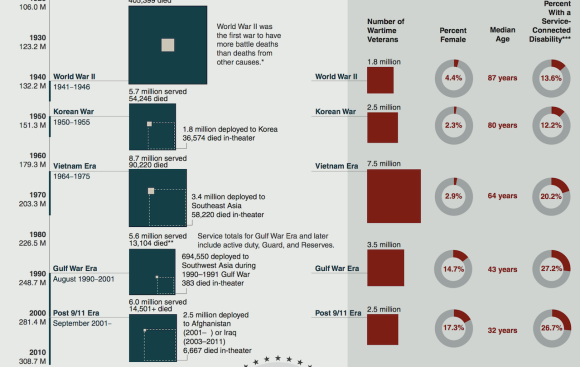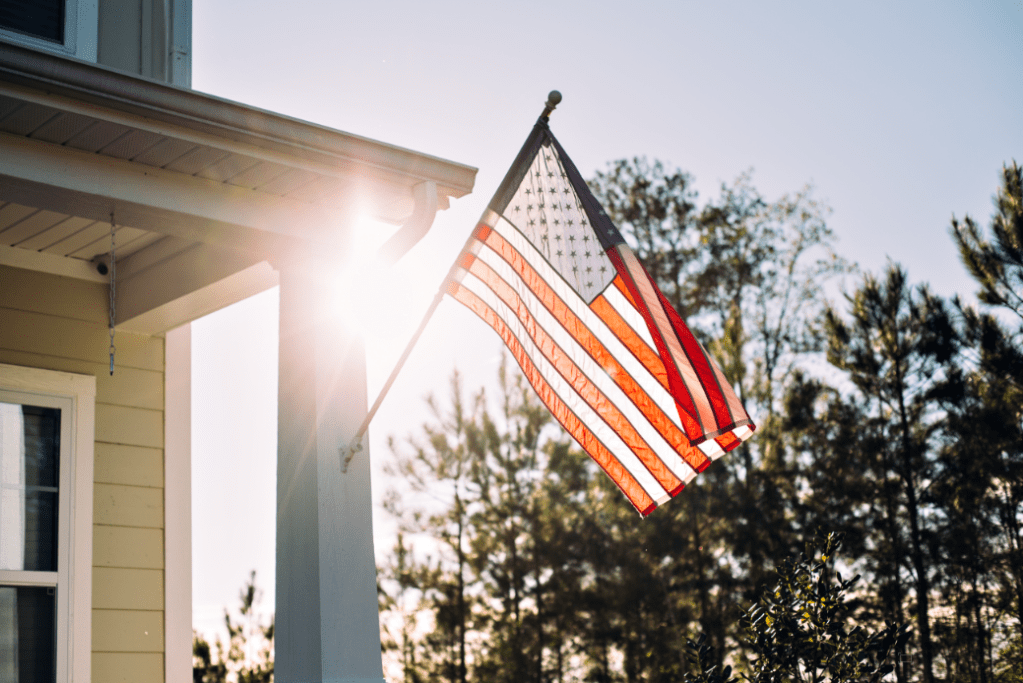Memorial Day’s call inside to each of us–a pining, proud, urgent, timeless welling of respect, grief, gratitude, and resolve–has deeply-buried roots that date back 155 years to another time of profound pain and civil strife. Historians say that 10,000 freed men and women who’d previously worked in slavery gathered with others on May 1, 1865, at the site of the Washington Race Course in Charlestown, S.C., to honor several hundred of the 600,000 to 800,000 soldiers who fell on both sides of the Civil War. Prayers, hymns, a solemn procession spoke of peace, loss, hope, and conviction that the lives sacrificed would matter for all time as a promise of better days ahead.
Officially, Waterloo, N.Y., is known as first American place to give due credit to memorializing its fallen soldiers, as on May 5, 1866, “it hosted an annual, community-wide event, during which businesses closed and residents decorated the graves of soldiers with flowers and flags.”

Source: Census.gov
Casualties of war and armed combat continue. Women and men keep signing up for duty to protect American life as we know it. They train and prepare themselves–if necessary–for the ultimate sacrifice in serving us. As of this report, about 1.4 million people serve in the U.S. armed forces, and there are about 18.2 million living veterans who’ve done so, some 52,000 of whom have sustained injury in combat, and more of whom have experienced Post Traumatic Stress Disorder. In my lifetime alone, more than 100,000 U.S. armed services members have died working to safeguard my liberties, my way of life, my ability to prosper. Moreover, one of every four men and women who’ve served during those past 65 years now lives with a disability.
Sadly, we–as citizens, as a people–take them for granted. We value their service and sacrifice all too little. Home building and home builders recognize this and want to change it.
We pause in life, in business as usual, in normal activities, to honor those men and women and those men and women’s families and loved ones, who’ve sacrificed so that we can know life, business as usual, and normal activities as we do. It’s fitting. To live a moment of reverence, esteem, and thankfulness–truly, to honor–is both to feel and to act fittingly as people who care–for their own loved ones and for others’.
Memorial Day 2020 could and can be one of America’s bright-line moments. It could and can be the bright line across which people resolve to return to work, to return to life, to return to business as usual, and return to normalcy–not what was, but what is and will be–as a people. Free to honor, to thank, to mourn, and to celebrate our commonness and shared dreams, and commitment to both life and livelihood in better days ahead.
Memorial Day 2020 could, if we want it to, be a moment we choose, if fleetingly, to de-polarize, to set divisiveness aside, to suspend grudges, suspicion, and disbelief. A day in the life where one and all belong in a place where people together honor the fallen, at home on this continent, in this small world and short life.
Few things work so powerfully as a home does to suspend disbelief.
Unfathomably deep human instincts and reflexes, brain chemistry, and mental muscle memory that date back to 250,000 years in time trigger an array of disbeliefs that come with the primal turf of human experience.
Here’s are examples of a few common disbeliefs that unconsciously motivate us.
- That one can ever know safety.
- That one can ever feel peace of mind.
- That one can ever experience well-being.
- That one can ever fully sense sanctuary.
- That one can ever belong.
A home matches up with us–in strength, usefulness, and aesthetic or emotional appeal. Its job is specifically to suspend disbelief, stem the release of cortisol, and tamp down hardwired fight-or-flight impulses that suspect and detect peril and risk at every turn, and cause us instantly, involuntarily, to recoil, or to lash out.
A superpower that homes and communities exerts calls off the neurochemical impulse dogs.
This is why we say there’s no place like it. This is why men and women who work to match physical structure and systems to people who need them for that superpower–that suspension of disbelief–do wondrous work.
And this is why men and women who take extra time, and give extra money, and provide extra material, and offer extra products, and perform extra tasks, and get others to do the same do especially wondrous work. For these people, the purpose of work and life are not bottom-line profitability. Nor is it neatly compartmentalized into double-, nor triple-bottom-line goals. There’s one purpose tying economic, social, and environmental outcomes as a single, equally-binding stakeholder goal.
Now, an often-quoted piece of business advice from Andrew Carnegie–in a 1889 essay entitled “Wealth”–counseled young, ambitious overachievers was to look at a career span in three distinct stages.
“Spend the first part of your life getting as much education as possible, to spend the second part making all the money you could, and to spend the last part giving it all away for worthwhile causes.”
Carnegie’s essay stood as business ambition’s gospel for the ages, but as this Harvard Business Review article notes, it’s not exactly being taken literally in an increasingly double- and triple-bottom-line world of business and stakeholders. Author Paula Goldman, VP and global lead for impact investing at Omidyar Network, writes:
“Today, business leaders are not only trying to address community and global problems earlier in their lives; they are also questioning the traditional divide between commerce and philanthropy. As prominent hedge fund manager Bill Ackman told me, ‘When I graduated from business school I thought business was about making money and philanthropy was about doing good. Now I think both can be used as methods for changing the world.’”
This is where people–home building people–like PulteGroup divisional execs Charlie Tipton and Sean Strickler come into the story here.
Charlie, you see, is Coastal Carolinas division president at Pulte, and Sean is his counterpart, West Florida division president, and both have taken an active, hands-on-hearts-in role in Pulte’s 10-year-old Built to Honor initiative, which we salute as our public builder Hearthstone BUILDER Humanitarian Award winner for 2020.
Charlie and his Coastal Carolinas team have developed and delivered six of the Built to Honor home projects Pulte and its partners have been able to hand over in support of, at the latest count, 57 servicemen and women as they build and rebuild their own and their families’ lives after disabling trauma in the line of duty.
Here’s a snippet of BUILDER contributor Lydia Lee’s official story on the Pulte-Hearthstone salute.
Officially launched as a company-wide program in 2013, Built to Honor started back in 2010, when individual divisions sponsored a couple of homes. Pulte donates the lot on which the home is built and the staff time for project management, and it typically pays any other costs that are not covered. The firm coordinates in-kind contributions from trade partners, who donate the labor, and from suppliers like James Hardie, Cosentino, and Whirlpool, who provide building materials and furnishings. These production homes are personalized, decorated, and delivered fully furnished to the veterans and their families.
“We’re so humbled and grateful for this honor. It makes you realize, when you think about it, what a wonderful thing we get to do for a living,” says Ryan Marshall, president and CEO of PulteGroup. “We and our partners get to play a major role in one of the most meaningful parts of people’s lives, their homes. Getting to do what we do for the benefit of people who need homes, need communities, need the kind of connections we’re good at—it adds a level of purpose and mission to our company.”
Charlie Tipton grew up and studied construction management out of Statesboro, Ga.-based Georgia Southern specifically for this. Starting 19 years ago, fresh out of college, he interned at Centex’s Atlanta division, worked his way up to field manager. After the Centex-Pulte combination, when the Built to Honor’s project came along in 2013, for U.S. Air Force Staff Sargent Robert Wright, Tipton got the nod from division executives to head construction on the home.
“We engineered the home carefully, with universal and wheelchair accessible design features, with special focus on the four kids and their needs,” says Tipton. “We spent a lot of time with Sargent Wright and his family through the process, so that we could match the home to their lives. It’s the most gratifying thing about working for Pulte, which has service to others deeply ingrained in our culture. I can think of no better person to put this effort in and get others to do the same than somebody who’s put their lives on the line for us.”
Tipton’s team–and their partners in the project, including Building Homes for Heroes–delivered its most recent Built to Honor home in Myrtle Beach, in Nov. 2019, for Marine Corporal Daniel Dobay and his wife Casey. Cpl. Dobay served in the U.S. Marine Corps for seven years, sustaining injuries from a homemade explosive device while serving his second tour in Afghanistan in March 2011. “We were able to do a house in their own neighborhood, near friends and family, where now, their living can take place in a single-story home,” says Tipton. “Cpl. Dobay is one of the most positive people I’ve ever known, and he is an inspiration to the entire team.”
Like his Carolinas-based counterpart, Sean Strickler’s start with Pulte–when the company was Michigan-based–came the moment he graduated from Michigan State University with his degree in construction management.
“Pulte recruited pretty heavily at that time at Michigan State, and I started there as a new-home sales counselor 26 years ago,” says Strickler. After various roles, moving up the ladder in sales and operations, Strickler stepped up as West Florida division president in 2015.
Among the three Built to Honor projects the West Florida team has completed, Strickler’s immediate thoughts gravitate to last year’s efforts on behalf of Navy veterans Jerry and Jeaniel Whatts, in the Tampa-area community of Riverview.
“The biggest thing that drew me in to doing this coming out of college was the opportunity you have to mean something in somebody’s life, their most meaningful days and nights, and the times that matter most to people in their home,” says Strickler. “The Built to Honor initiatives truly energize and elevate that opportunity, with team members, our trade partners, the community. Getting to do this, and even more important, getting to do this in a way that gives back to men and women like our Built to Honor families is all I could hope for in my work.”
“Whoever’s hands touched this building, they did it with love and care, and it shows,” says Jeaniel Whatts in this video.
It’s work of people like Tipton and Strickler that makes it so that deserving people like Jerry Whatts can suspend his disbelief that he would ever know the new life he gets to live.
That’s why the Heartstone BUILDER Humanitarian Award is so important. It sparks that motivation in builders like Charlie Tipton and Steve Strickler and their entire PulteGroup team, and the entire ecosystem of partners who make homes and communities, to use this superpower. To suspend disbelief.



